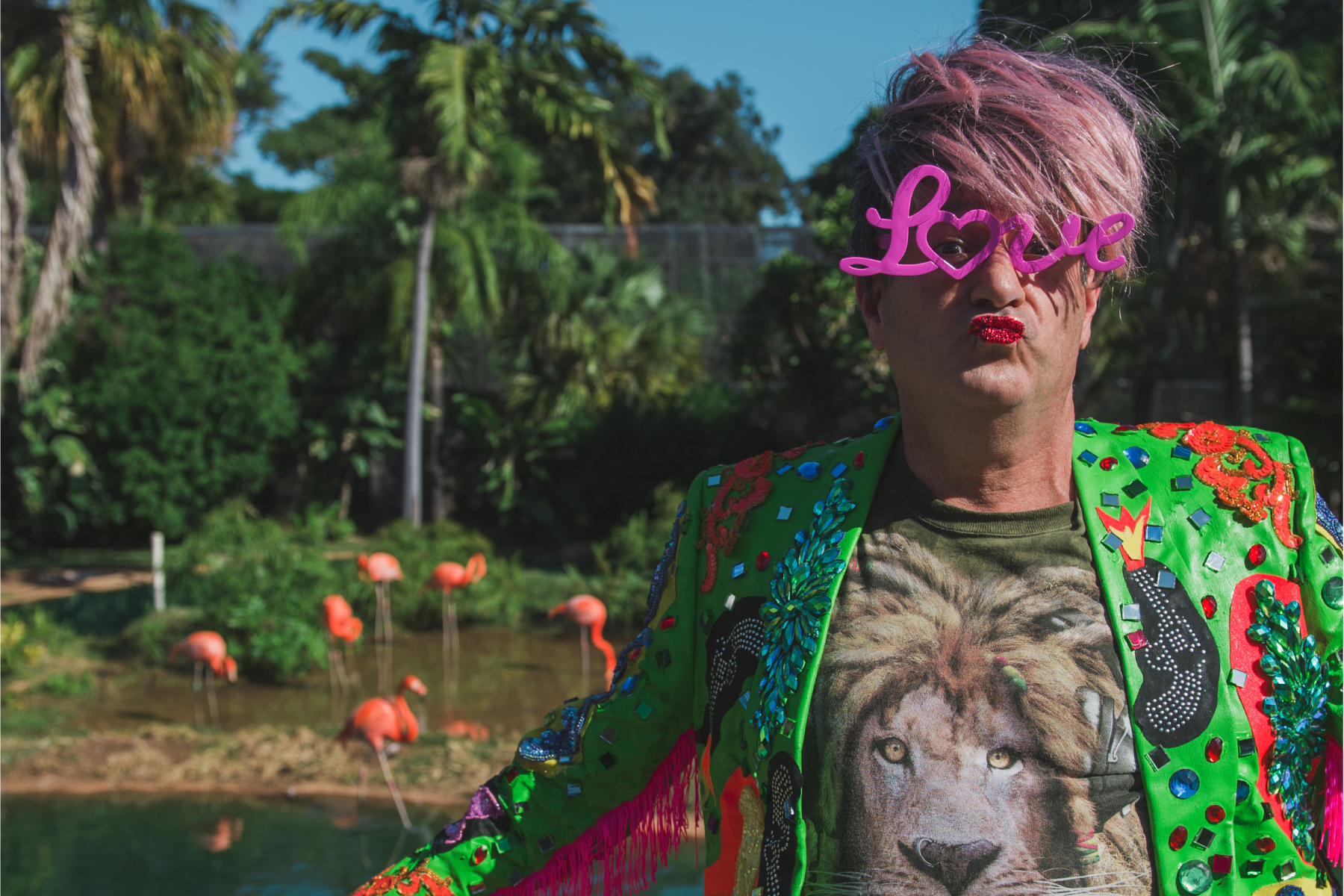Hawai‘i performance artist Robert Reed draws inspiration from his own life and challenges everything from faith to gender to propaganda.
Text by James Charisma | Images by John Hook
Dressed in a skintight white spandex suit resembling a blow-up doll, performance artist Robert Reed emerged from the Honolulu Museum of Art at Spalding House pool like the goddess Venus. Surrounding him was a skirt overflowing with neon inflatable toys, decorated lawn flamingos, and beach balls; on his head he wore a massive headdress of bright plastic toys and colorful Mylar balloons. Like a Miss Chiquita Banana designed by John Waters, Reed was terrifying and magnificent, a shining spectacle who, with headdress, stood 10 feet tall.
In this guise, one of many he has created, Reed was the centerpiece of 2012’s Unnecessary Seduction, an interactive exhibition that also included an air-mattress maze, horseshoes, and kick croquet—“[people] put on water-filled inflatable shoes and kick water-filled beach balls,” he explains. It was the product of Reed’s second residency at the museum, a satirical take on Hawai‘i’s local tourism industry and false promotions of the idyllic paradise identity.
“[Growing up in the 1960s] was quite exciting in a horrific way. Everyone was experimenting with everything, and we even landed on the moon,” Reed says. “Our neighbors were jealous because we went to McDonald’s on Friday nights and thought it was glamorous.”
Reed is originally from Independence, Missouri, an “all-white Christian community in the Midwest that believes the second coming of Christ will happen there,” he says. He was working as a flight attendant based out of Washington D.C. and New York when he first visited Hawai‘i on vacation in 2001. He fell in love with the islands (and his future husband), and decided to stay, attending the University of Hawai‘i at Mānoa to study glass and metal.
While taking a class on fiber art and materials, Reed realized that he had been making, and performing in, wearable art for years. “At theatre events or gay pride parades in New York, I would create elaborate costumes and routines,” Reed recalls. “I dressed up like Cyndi Lauper on a float next to Greg Louganis one year. Never thought of it as performance, but it was.”
After earning his bachelor’s degree in art, he continued on to the master’s program, specializing in fiber with an emphasis on performance. For his MFA thesis exhibition in 2011, Reed created Par for the Course, an interactive miniature golf course constructed from old kitchen appliances, stoves, refrigerator doors, bed springs, birdcages, and items from Reed’s childhood, a reference to his coming of age during the Cold War and American containment culture of the 1950s and 1960s.
“[Growing up in the 1960s] was quite exciting in a horrific way. Everyone was experimenting with everything, and we even landed on the moon,” Reed says. “Our neighbors were jealous because we went to McDonald’s on Friday nights and thought it was glamorous. Anything instant and plastic was the bomb. … I’m fascinated now by how it was all marketed so well to make us desire it, like a big lie that everyone followed. It was all a game that nobody could win, which is what inspired the miniature golf course. Playable yet dysfunctional.”
 Reed’s work draws inspiration from his own life and challenges everything from faith to gender to propaganda. His diverse body of work includes “Committed,” a wedding dress/straitjacket hybrid; “Kitty Poole,” an inflatable pool dress with a swim-float wig; and “McGeisha,” a kimono made up of fast-food wrappings.
Reed’s work draws inspiration from his own life and challenges everything from faith to gender to propaganda. His diverse body of work includes “Committed,” a wedding dress/straitjacket hybrid; “Kitty Poole,” an inflatable pool dress with a swim-float wig; and “McGeisha,” a kimono made up of fast-food wrappings.
For one of Reed’s favorite performances, “Immigrate, Imitate, Prophet, Profit,” he dressed up as a fortune-telling parrot and distributed meaningless fortune cookies made from local postcards in Chinatown, repeating back whatever was said to him. “Most people laughed. But then at the end, a young woman was outraged,” Reed recalls. “She said really hateful things that I just repeated back. She went to get her large boyfriend to defend her, and he went off on me as well, but I kept repeating their words in my ridiculous costume. I still don’t think they got it. They were so upset over their own words.”
Reed’s often larger-than-life personalities and performances provoke an immediate reaction from those he encounters, including the occasional hateful response. The nature of his work jars audiences out of complacency. “People in general, I think, are followers—monkey see, monkey do,” Reed says. “It’s easier to just accept something and not question it, and I think artists question everything. … We need to question the way things are in every aspect of our lives, art or otherwise. This is how new ideas and identities are formed; how change happens.”
For more information, visit fabulousrobertreed.com.
Story previously seen on fluxhawaii.com.


